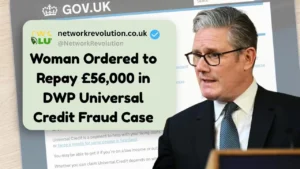The Department for Work and Pensions (DWP) has announced sweeping welfare reforms that will reshape income support for millions of Britons. Under the Universal Credit and Personal Independence Payment Bill, payments will rise annually between 2026 and 2030, guaranteeing a £725 boost for single claimants aged 25 and over by the end of the four-year plan.

While the government describes it as a “guaranteed income rise”, disability campaigners warn that the accompanying cuts to health-related benefits will hit the most vulnerable hardest. The reforms, set to begin in April 2026, mark a delicate balancing act between tackling cost-of-living pressures and controlling long-term welfare spending.
“This is a structural reform of welfare — predictable income increases, but painful trade-offs for those with health challenges,” said Dr. Peter King, Senior Policy Fellow at the Institute for Fiscal Studies (IFS).
Also Read Woman Ordered to Repay £56,000 in DWP Universal Credit Fraud Case
Woman Ordered to Repay £56,000 in DWP Universal Credit Fraud Case
Introduction to the 2026 Benefit Reforms
The new DWP bill promises above-inflation increases to Universal Credit (UC) for four consecutive years, providing financial stability during an uncertain economic period.

Unlike traditional upratings that follow inflation or wage growth, these increases are pre-determined by law, ensuring households know exactly how much more they will receive each year.
The DWP confirmed that nearly four million households will benefit, with the first increase due in April 2026.

Key Features / Overview
| Feature | Details (2026–2030) |
|---|---|
| Policy Name | Universal Credit & Personal Independence Payment Bill |
| Implementation Start | April 2026 |
| Duration of Fixed Increases | Four years (2026–2030) |
| Guaranteed Uplift by 2029–30 | £725 annually for single claimants aged 25+ |
| Estimated Beneficiaries | 4 million households |
| Purpose | To provide predictable income growth and inflation protection |
| Concern | LCWRA benefit cuts affecting disabled claimants |
| Administered by | Department for Work and Pensions (DWP) |
The Four-Year Universal Credit Uplift
Under the new framework, benefit increases are legally guaranteed rather than dependent on yearly government reviews. This ensures consistent income growth for claimants amid ongoing cost-of-living challenges.
| Financial Year | Annual Increase (%) | Projected Annual Gain (£) | Cumulative Increase (£) |
|---|---|---|---|
| 2026–2027 | 2.3% | £200 | £200 |
| 2027–2028 | 3.1% | £225 | £425 |
| 2028–2029 | 4.0% | £250 | £675 |
| 2029–2030 | 4.8% | £250 | £725 Total |
By the final year, a single adult aged 25 or over on standard Universal Credit will gain approximately £725 more annually than under current inflation-linked systems — a 25–30% stronger outcome compared to existing uprating formulas.

“This provides clarity and predictability for low-income households, something long missing from welfare policy,” noted Sarah Keenan, Senior Economist at the Resolution Foundation.
Eligibility Rules: Who Benefits from the £725 Increase
The uplift applies automatically to:
- Single claimants aged 25+ on Universal Credit.
- Couples and families whose UC payments are based on household income.
- Low-income workers receiving Universal Credit top-ups.
Other income-tested benefits — such as Income Support or income-based JSA — will follow the same uplift pattern.
Households already receiving Universal Credit housing or child elements will also see proportional rises in their total entitlement.
Pensioners, however, are not included under this scheme, as the State Pension remains governed by the Triple Lock formula.
Reductions to LCWRA Health Support
While millions will benefit from the uplift, the reforms also make controversial cuts to the Limited Capability for Work and Work-Related Activity (LCWRA) element of Universal Credit.
Currently, claimants in this group receive £97 per week, but starting April 2026:
- Existing claimants will keep the £97 rate (frozen, not increased).
- New applicants will receive only £50 per week — almost half the current amount.
The government estimates that this change will save nearly £1.2 billion annually by 2028.
“These reforms reward work and ensure the system is fair,” said a DWP spokesperson, arguing that transitional protection will safeguard the most vulnerable.
However, charities say this will deepen hardship for people unable to work due to disability or chronic illness.
Financial Impact: Winners and Losers
| Category | Outcome | Explanation |
|---|---|---|
| Universal Credit Claimants (Single, 25+) | Gain £725/year | Benefit from above-inflation increases |
| Families on Universal Credit | Gain | Higher base allowances support children and dependents |
| Low-Income Workers | Gain | UC top-ups increase proportionally |
| Existing LCWRA Claimants | Neutral | Retain £97/week, but frozen (no inflation rise) |
| New LCWRA Claimants (from 2026) | Lose up to £47/week | New rate set at £50/week |
| Disabled or Seriously Ill (New Applicants) | Major Loss | Could lose up to £12,000/year in severe cases |
According to Scope UK, the changes “risk creating a two-tier welfare system where health-related needs are undervalued.”
Why the Reforms Were Introduced?
The government says the new system is about “modernizing welfare for the long term”. The DWP highlighted three core goals:
- Stability for Working-Age Claimants – predictable increases that make household budgeting easier.
- Fairness Across the System – ensuring benefits align with work incentives.
- Fiscal Responsibility – controlling welfare spending growth amid an ageing population.
Economists view the approach as fiscally cautious yet politically strategic, providing visible relief for millions while reducing future obligations to high-cost disability benefits.
“It’s a balancing act — the Treasury gains stability, but the social cost may be high,” said Prof. Jonathan Portes, a public policy expert at King’s College London.
Wider Economic and Social Impact
The £725 rise will inject an estimated £4.8 billion into the economy over four years. Analysts expect most of that money to be spent on essential goods and services, boosting local economies.
However, social policy experts warn that freezing LCWRA rates could worsen inequality. Charities such as Disability Rights UK predict increased hardship, especially for claimants unable to transition into work due to severe conditions.
The reforms also signal a policy shift toward rewarding employability, rather than purely maintaining income levels.
Why It Matters?
The 2026–2030 welfare package illustrates the government’s dual agenda:
- Support for working-age and low-income earners, through a guaranteed uplift.
- Restructuring of health-related benefits, reducing dependency on state aid.
For millions of struggling households, the guaranteed uplift represents welcome stability. But for thousands of disabled people and carers, it could mean a decade of shrinking support.
“The government’s challenge now is not just fiscal, but moral,” said Helen Walker, CEO of Carers UK. “We cannot balance the books on the backs of the sick.”
Recent Developments
- February 2025: Universal Credit and PIP Bill passes its second reading in Parliament.
- April 2026: First 2.3% increase comes into effect.
- September 2026: New LCWRA rules begin for all new applicants.
- 2029–2030: Full £725 annual rise achieved for standard claimants.
Further reviews of disability support and PIP eligibility are expected by 2027.
FAQs
1. When will the £725 increase take effect?
The increases begin in April 2026 and will phase in annually until 2030.
2. Do I need to apply for the increase?
No, the rise is automatic for eligible claimants receiving Universal Credit or income-based benefits.
3. Will disability claimants also benefit?
Some will, but those applying for LCWRA after April 2026 will face reduced weekly support.
4. How much will LCWRA be after April 2026?
Existing claimants stay at £97 per week, while new applicants receive £50 per week.
5. How many people will gain from the reform?
Around four million households will see higher Universal Credit payments.
6. Will this replace cost-of-living payments?
Not directly — this is a structural increase, separate from temporary cost-of-living schemes.

